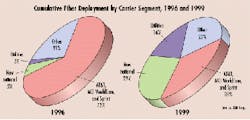Year 2000 fiber deployment in North America expected to reach 11 million km
Fueled by regulatory changes, stronger competition, and exploding bandwidth demand, long-distance carriers in North America will deploy 11-million km of fiber in 2000. That's more than four times their annual fiber deployment in 1997, according to new research from KMI Corp., a market research firm in San Mateo, CA, specializing in worldwide fiber-optic markets.
According to the new report, "Fiberoptic Networks of Long-Distance Carriers in North America," regulatory changes in Canada, Mexico, and the United States have accelerated competition in the long-distance industry. From 1997 through 1999, 13 new carriers lit up new fiber-optic networks. These new carriers, along with regional players and utilities, are competing with traditional carriers by building-out national networks.
For example, the report cites that AT&T, MCI, Sprint, and WorldCom accounted for nearly three-fourths of cumulative fiber deployment in 1996. But by 1999, their share of U.S. fiber assets slipped to just 30%, while new national carriers and utilities accounted for 45% of U.S. long-haul fiber.The provision of dark fiber under indefeasible right-to-use (IRU) also drove new builds and helped defray network construction costs. From January 1998 through June 1999, U.S. long-haul carriers provided more than 64,000 route-mi of dark fiber under IRU, a multibillion-dollar industry.
According to the report, the strong growth in long-distance fiber deployment will not continue. Most major carriers with plans for large national networks will have completed their long-haul routes by the end of 2000.
Annual long-distance fiber deployment in North America is expected to slow from 11 million fiber-km in 2000 to 8 million fiber-km in 2004 as sufficient capacity is reached and carriers focus on metropolitan and access networks to bring fiber closer to the end user.
Other key trends pointed out in KMI's report include average fiber counts on new deployments in North America growing from 38 fibers per cable in 1997 to 90 fibers per cable in 2000. It was also noted that 22 of the 39 U.S. long-distance carriers studied in the report had deployed dense wavelength-division multiplexing in their networks. Also, the average number of points-of-presence per carrier rose from 67 in 1991 to 100 in 1998, confirming a trend toward larger fiber-optic networks serving more cities.
The complete report is available from KMI by calling (800) 343-4035 or (401) 849-6771, fax (401) 847-5866, or e-mail: [email protected].

